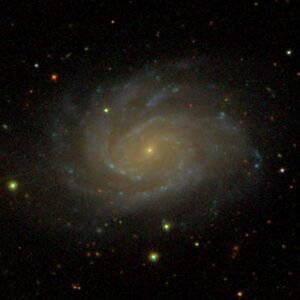Astronomy:NGC 514
| NGC 514 | |
|---|---|
 SDSS image of NGC 514 | |
| Observation data (J2000 epoch) | |
| Constellation | Pisces |
| Right ascension | 01h 24m 03.89603s[1] |
| Declination | +12° 55′ 02.8476″[1] |
| Redshift | 0.008246±0.000010[2] |
| Helio radial velocity | 2,472 km/s[3] |
| Distance | 82.8 Mly (25.4 Mpc)[3] |
| Apparent magnitude (V) | 11.65[4] |
| Characteristics | |
| Type | SAB(rs)c[5] |
| Apparent size (V) | 3.5′ × 2.8′[6] |
| Other designations | |
| UGC 947,[7] PGC 5139[6] | |
NGC 514 is a low-luminosity,[8] intermediate spiral galaxy in the equatorial constellation of Pisces, located at a distance of approximately 83[3] million light-years from the Milky Way. It was discovered on 16 October 1784 by astronomer William Herschel.[9] The general form of the galaxy is specified by its morphological classification of SAB(rs)c,[5] which indicates it has a weak bar system at the core (SAB), an incomplete ring formation around the bar (rs), and somewhat loosely-wound spiral arms (c). This galaxy has an H II nucleus[10] with an extended region that displays weak emission lines in the optical range, but not in the near infrared.[5] The suspected supermassive black hole at the core has an estimated mass of 3.2×106 M☉.[8]
In October 2020 a Type 1a supernova, 2020uxz was detected in NGC 514.[11]
References
- ↑ 1.0 1.1 Brown, A. G. A. (August 2018). "Gaia Data Release 2: Summary of the contents and survey properties". Astronomy & Astrophysics 616: A1. doi:10.1051/0004-6361/201833051. Bibcode: 2018A&A...616A...1G. Gaia DR2 record for this source at VizieR.
- ↑ Rhee, M. H.; van Albada, T. S. (February 1996). "Short WSRT HI observations of spiral galaxies.". Astronomy and Astrophysics Supplement 115: 407–437. Bibcode: 1996A&AS..115..407R.
- ↑ 3.0 3.1 3.2 Tully, R. Brent et al. (2016). "Cosmicflows-3". The Astronomical Journal 152 (2): 21. doi:10.3847/0004-6256/152/2/50. 50. Bibcode: 2016AJ....152...50T.
- ↑ Armando, Gil de Paz et al. (2007). "The GALEX Ultraviolet Atlas of Nearby Galaxies". Astrophysical Journal 173 (2): 185–255. doi:10.1086/516636. Bibcode: 2007ApJS..173..185G.
- ↑ 5.0 5.1 5.2 Martins, Lucimara P. et al. (May 2013). "A spectral atlas of H II galaxies in the near-infrared". Monthly Notices of the Royal Astronomical Society 431 (2): 1823–1839. doi:10.1093/mnras/stt296. Bibcode: 2013MNRAS.431.1823M.
- ↑ 6.0 6.1 "NASA/IPAC Extragalactic Database". Results for NGC 514. http://nedwww.ipac.caltech.edu/cgi-bin/nph-objsearch?objname=NGC+514&img_stamp=yes&extend=no.
- ↑ "NGC 514". SIMBAD. Centre de données astronomiques de Strasbourg. http://simbad.u-strasbg.fr/simbad/sim-basic?Ident=NGC+514.
- ↑ 8.0 8.1 Dong, X. Y.; De Robertis, M. M. (March 2006). "Low-Luminosity Active Galaxies and Their Central Black Holes". The Astronomical Journal 131 (3): 1236–1252. doi:10.1086/499334. Bibcode: 2006AJ....131.1236D.
- ↑ "New General Catalog Objects: NGC 500 - 549" (in en-US). http://cseligman.com/text/atlas/ngc5.htm#514.
- ↑ Ho, Luis C. et al. (October 1997). "A Search for "Dwarf" Seyfert Nuclei. III. Spectroscopic Parameters and Properties of the Host Galaxies". Astrophysical Journal Supplement 112 (2): 315–390. doi:10.1086/313041. Bibcode: 1997ApJS..112..315H.
- ↑ "Supernova 2020uxz in NGC 514". http://www.rochesterastronomy.org/sn2020/sn2020uxz.html.
External links
- NGC 514 on WikiSky: DSS2, SDSS, GALEX, IRAS, Hydrogen α, X-Ray, Astrophoto, Sky Map, Articles and images
Coordinates: ![]() 01h 24m 03.9s, +12° 55′ 03″
01h 24m 03.9s, +12° 55′ 03″
 |

